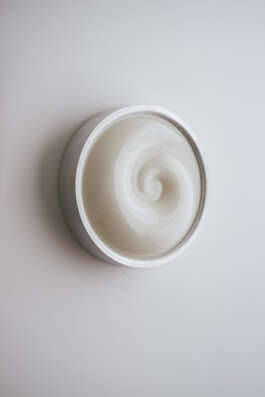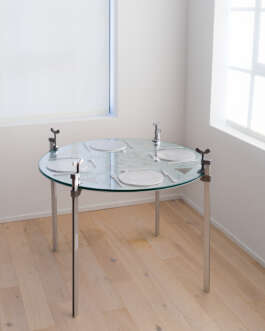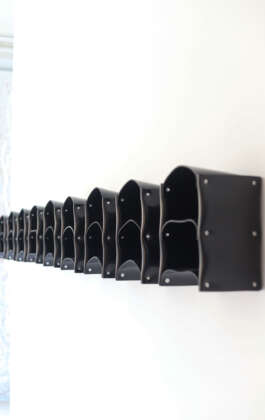



©Anna Dawson_Valley - Shell_2025_Courtesy of playinghouse
COLLECTIBLE In-Depth
Playinghouse
August 2025
This series, COLLECTIBLE In-Depth, unveils the backstage of contemporary creation. Tackling various topics from personal designer processes to the position of collectible design on the global design market, COLLECTIBLE In-Depth offers different views to suit all tastes. Today we speak with Playinghouse.
FOR GALLERISTS
COLLECTIBLE: How did you get into COLLECTIBLE design? Why did you start your gallery?
The Gallery: Playinghouse is an art and design platform that explores the malleable intersection of the functional, the familiar, and the inventive. Cofounded by Angela Yang, Clara Leverenz, and Sophie Taylor, the collective bridges the gap between the fine art and design worlds, fostering provocative dialogue among multihyphenate creatives and frequently partitioned cultural audiences.
Collectible design embodies such fluidity, cultivating the potential for beauty and playfulness in the objects that occupy our day-to-day spaces and manifesting the radical potential for expression in all corners of our everyday lives. Such intentionality encourages caring looking—and subsequently social consciousness and community—in an increasingly polarized global environment.
C: What is the relation you hold with the designers you work with?
The Gallery: Playinghouse prioritizes designers’ and artists’ voices, shaping spaces that encourage experimentation and expressive possibility. At root, playinghouse is a collective—cofounded by Angela Yang, Clara Leverenz, and Sophie Taylor—built upon a foundation of collaboration.
The curators’ relationship with artists echoes such interchange, dialoguing with makers to further and support their establishment and exploration of their own voices—without forcing assertive direction. The collective sees its role as a means to connect creatives with new audiences and as an opportunity to draw out connections between different artists’ work to enrich and heighten each of their practices. playinghouse is the unique whole born from the collage of the individualistic artists that make up its parts and pieces.
FOR DESIGNERS
The design process
COLLECTIBLE: What kind of material trends or changes are you noticing? In what way are these shifts influencing COLLECTIBLE design?
Designers: The creatives celebrated by playinghouse variously demonstrate an awareness of the ever-changing circumstances of our everyday lives. Lighting designer Anna Dawson, for example, responds to such fluctuations, remarking: “I have noticed that in a turbulent economy, when everyone’s wallets are strained, most collectors' tastes become quite conservative.
Experimental materials are perceived as too risky and much design work being produced tends to return to established media like wood, metal, and upholstery. My design work, by contrast, weaves together the exploratory and the traditional: it reworks old languages—drawing inspiration from the likes of mid-century Italian designs—in unexpected materials and finds the potential for innovation within the timeless.
C: How do you navigate the tension between innovation and tradition in your approach to designing COLLECTIBLE objects?
Designers: The objects displayed by playinghouse blur the boundary between utility and artfulness. The Italian architect and designer Francesco Rosati articulates: “I am interested in conceptual innovation rather than technical invention and how to reimagine conventional objects in new ways.
My design for Silver Tablecloth - Idea for a Table abstracts and reinterprets a tablecloth, distilling its function into pure idea: it becomes an ornamental subject to dine around rather than a practical table covering. The cut-out details of my metal tabletop gesture towards its ontological origins while resisting literalism. The tension between traditional forms and novelty fascinates me; tradition can nevertheless find many contemporary expressions.
C: How did you get into collectible design? Why did you focus your practice on this type of design rather than industrial design?
Designers: The collaborative spirit that defines playinghouse extends to the makers we celebrate, who prioritize meaningful processes. Montreal-based Atelier Fomenta—Julia Arvelo, Florence Barnabé, and Muriel Bentolila—explains their approach: "Our practice stems from the desire to work at a slower pace while finding inspiration in the principles of industrial design. We work hand in hand with local artisans, building relationships with them, making and designing with care and attention to detail and functionality. Collectible design allows us to play a bit more with the limits of how we perceive 'conventional' design. At Fomenta, a soft bookshelf can totally be functional.

© Francesco Rosati_Silver Tablecloth - Idea for a Table_2025_Courtsey of playinghouse

© Atelier Fomenta_ Rubber Libraries_2025_

©Anna Dawson_Valley - Shell_2025_Courtesy of playinghouse
COLLECTIBLE In-Depth
Playinghouse
August 2025
This series, COLLECTIBLE In-Depth, unveils the backstage of contemporary creation. Tackling various topics from personal designer processes to the position of collectible design on the global design market, COLLECTIBLE In-Depth offers different views to suit all tastes. Today we speak with Playinghouse.
FOR GALLERISTS
COLLECTIBLE: How did you get into COLLECTIBLE design? Why did you start your gallery?
The Gallery: Playinghouse is an art and design platform that explores the malleable intersection of the functional, the familiar, and the inventive. Cofounded by Angela Yang, Clara Leverenz, and Sophie Taylor, the collective bridges the gap between the fine art and design worlds, fostering provocative dialogue among multihyphenate creatives and frequently partitioned cultural audiences.
Collectible design embodies such fluidity, cultivating the potential for beauty and playfulness in the objects that occupy our day-to-day spaces and manifesting the radical potential for expression in all corners of our everyday lives. Such intentionality encourages caring looking—and subsequently social consciousness and community—in an increasingly polarized global environment.
C: What is the relation you hold with the designers you work with?
The Gallery: Playinghouse prioritizes designers’ and artists’ voices, shaping spaces that encourage experimentation and expressive possibility. At root, playinghouse is a collective—cofounded by Angela Yang, Clara Leverenz, and Sophie Taylor—built upon a foundation of collaboration.
The curators’ relationship with artists echoes such interchange, dialoguing with makers to further and support their establishment and exploration of their own voices—without forcing assertive direction. The collective sees its role as a means to connect creatives with new audiences and as an opportunity to draw out connections between different artists’ work to enrich and heighten each of their practices. playinghouse is the unique whole born from the collage of the individualistic artists that make up its parts and pieces.
FOR DESIGNERS
The design process
COLLECTIBLE: What kind of material trends or changes are you noticing? In what way are these shifts influencing COLLECTIBLE design?
Designers: The creatives celebrated by playinghouse variously demonstrate an awareness of the ever-changing circumstances of our everyday lives. Lighting designer Anna Dawson, for example, responds to such fluctuations, remarking: “I have noticed that in a turbulent economy, when everyone’s wallets are strained, most collectors' tastes become quite conservative.
Experimental materials are perceived as too risky and much design work being produced tends to return to established media like wood, metal, and upholstery. My design work, by contrast, weaves together the exploratory and the traditional: it reworks old languages—drawing inspiration from the likes of mid-century Italian designs—in unexpected materials and finds the potential for innovation within the timeless.
C: How do you navigate the tension between innovation and tradition in your approach to designing COLLECTIBLE objects?
Designers: The objects displayed by playinghouse blur the boundary between utility and artfulness. The Italian architect and designer Francesco Rosati articulates: “I am interested in conceptual innovation rather than technical invention and how to reimagine conventional objects in new ways.
My design for Silver Tablecloth - Idea for a Table abstracts and reinterprets a tablecloth, distilling its function into pure idea: it becomes an ornamental subject to dine around rather than a practical table covering. The cut-out details of my metal tabletop gesture towards its ontological origins while resisting literalism. The tension between traditional forms and novelty fascinates me; tradition can nevertheless find many contemporary expressions.
C: How did you get into collectible design? Why did you focus your practice on this type of design rather than industrial design?
Designers: The collaborative spirit that defines playinghouse extends to the makers we celebrate, who prioritize meaningful processes. Montreal-based Atelier Fomenta—Julia Arvelo, Florence Barnabé, and Muriel Bentolila—explains their approach: "Our practice stems from the desire to work at a slower pace while finding inspiration in the principles of industrial design. We work hand in hand with local artisans, building relationships with them, making and designing with care and attention to detail and functionality. Collectible design allows us to play a bit more with the limits of how we perceive 'conventional' design. At Fomenta, a soft bookshelf can totally be functional.

© Francesco Rosati_Silver Tablecloth - Idea for a Table_2025_Courtsey of playinghouse

© Atelier Fomenta_ Rubber Libraries_2025_